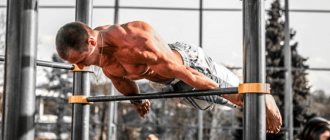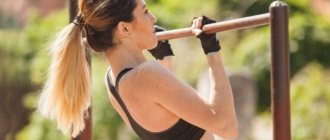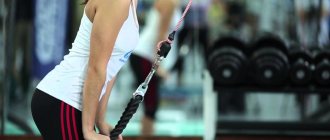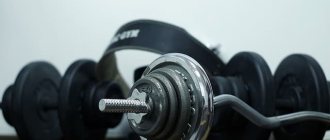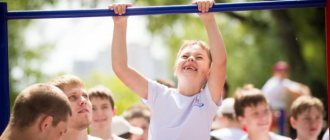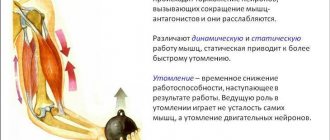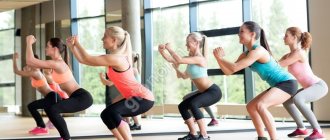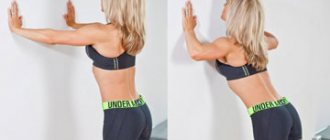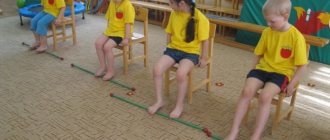Pull-ups – one of the most difficult exercises for beginners. Unlike squats or push-ups, not everyone can do a pull-up the first time. Many don't even know where to start.
Pull-ups are suitable for many people: men, women, teenagers and even children. You can exercise both at home and in the gym, and even on the street.
It is precisely because of its complexity that many teaching schemes for this exercise have been invented. They depend on the general physical preparation of the beginner and personal skills. Some will have to start from the very basics, while others will only need to improve the already developed technique. The main thing is to determine your level correctly.
The benefits of exercising on the horizontal bar
Everyone primarily associates the horizontal bar with pull-ups. Although this trainer has several uses. Even the smallest children can practice on it, performing a regular hang with a direct grip.
This activity relieves stress on the spine and forms correct posture. Hanging on a horizontal bar is necessary for the prevention and treatment of spinal curvatures.
- The most popular exercise - pull-ups strengthens the muscles of the back, shoulder and arms. They are loaded by the body's own weight when it is lifted. Strengthening the back muscle corset helps maintain a straight posture and greater endurance during physical activity.
- More complex complexes, such as inversion lifts, are performed by experienced athletes. They help to more actively develop the muscles of the arms and shoulder area, receiving greater load. Such complexes require not only high power expenditures, but also high concentration, which contributes to its further improvement.
- In addition to the back and arms, the abdominal muscles work while doing pull-ups on the horizontal bar. It tenses to increase the effort, thereby forming a beautiful slender stomach and sides.
Exercises on the horizontal bar
For a beginner turnstile, it is necessary to master the basics - these are classic pull-ups with a direct, reverse, narrow, normal and wide grip, reaching to the chest and behind the head. When you can perform at least 10 pull-ups with any grip, consider that you have reached a new level and you can master more complex exercises on the horizontal bar.
Return to content
On one hand
Try to use only 1 hand for pull-ups, placing the second behind your back; balance can be maintained by tensing the whole body and adjusting the center of gravity with your legs
With extra weight
Put a backpack on your shoulders, loading it with additional weight, first 5, then 10-15-20 kg, or tie a load to your belt, no matter what it is, be it bricks or bottles of water.
Return to content
Corner
The point is that you additionally load the abdominal muscles. The legs must be kept constantly bent at the pelvis by 90°.
Return to content
Exit by force
From a hanging position, you need to pull yourself up so that the horizontal bar is at waist level, while your body is in a vertical position, as if you are rising above the horizontal bar.
There are dozens of exercises on the horizontal bar for intermediate and advanced levels, but you can move on to them only after mastering the basics.
25 different pull-up variations from Chris Heria
Return to content
Where to begin?
Methodology for starting to do pull-ups on the horizontal bar:
- You need to start by determining your level of physical fitness and previously acquired skills. You can start exercising both at home and in the gym.
- Most often, the question of training is asked by beginners who absolutely do not know how to perform this exercise. Therefore, it is worth considering the learning process from the initial level. At this stage, you need to prepare your body for a certain type of physical activity, in this case, doing pull-ups on the horizontal bar.
- To make the effort to lift the body to the bar, it is necessary to strengthen the muscles involved in this process. This will make learning go much faster. The easiest way to do this is by practicing push-ups. During them, similar muscle groups work, but it is much easier to perform. This way your shoulders and back will be trained.
- The seated lat pull-down exercise will be more effective. It simulates the work of muscles during pull-ups as much as possible and allows you not only to train, but also to understand the processes occurring in the body during the exercise.
What exercises can replace pull-ups on a horizontal bar?
If you have just started training and cannot yet perform a single repetition of pull-ups, then do not despair. There are many exercises in bodybuilding that are interchangeable. If you still cannot do pull-ups, then after reading this article you will have the opportunity to conduct effective exercises. However, as soon as your muscles are strong enough, it is worth introducing pull-ups into your training program. This is due to the fact that the movements that replace them are more isolated and involve fewer muscles.
Here is a list of exercises that can temporarily replace various variations of pull-ups:
- Pull-ups, wide grip
- you can perform lat pull-downs towards the chest with a wide grip. - Pull-ups, reverse grip
- You can also perform rows towards the chest using an appropriate grip. - Pull-ups by the head
- pull-downs of the upper block behind the head. - Pull-ups, narrow grip
- block rows using a narrow grip. - Pull-ups, parallel grip
- rows on a block using a parallel grip.
As you can see for yourself, all types of pull-ups can be replaced with other movements. But I would like to remind you that you should do this until you learn to pull yourself up. How to do this will be discussed below. At the same time, you shouldn’t completely abandon substitute movements, and you can use them as additional ones to pull-ups.
How to learn to do pull-ups?
- In order to learn this exercise, you need to choose the most suitable technique for yourself. Exercises should gradually become more difficult as you get used to them. Continuity and systematicity of classes is important. As soon as you manage to pull yourself up for the first time on your own, you must definitely consolidate the acquired skill.
- Along with performing the exercises, it is important to learn the correct grip, simple hanging on the horizontal bar and precise execution technique.
- At first it will be difficult to do more than 1-2 lifts at a time. Therefore, after them, you need to continue to work on the established program, complicating it and without stopping trying to lift the body.
- Over time, full pull-ups will replace simple preparatory exercises, and all that remains is to increase the number of exercises and approaches. With the onset of this moment, you need to carefully monitor the technique and constantly practice it.
In addition to exercise machines, you need to stretch your back muscles to better feel their work. It is performed before training as a warm-up. During training, you should alternate approaches to block pulls and direct pull-ups using any initial technique.
The right technique for a beginner from scratch
For beginners, there are several ways to start training:
Blocks
Blocks and reverse pull-ups help to train at the initial stage, when all skills are reduced to zero.
In these exercises, the athlete pushes off from a support and, bending his arms at the elbow to an angle of 45 or 90 degrees, fixes his position on the horizontal bar.
You need to hold this position for as long as possible, but at least 10 seconds in each position.
Reverse pull-ups
The reverse pull-up exercise can be a full-fledged training complex. It consists of a group of different blocks.
Starting position – elbow angle 45 degrees. After hanging in it for the set time, the athlete smoothly extends his arms to a right angle and is again fixed for a while, after which the angle increases to 120 degrees.
During exercise, the strength will gradually increase, and you can, having lowered yourself to the highest bend angle, try to rise, also fixing the blocks. First 90, then at the top point - 45 degrees. The final stage is the transition from short bends up to a certain block to a full pull-up without stopping.
Pushing off with one leg from the support
Pushing off with one leg from the support is a less effective method. It is used rather as a complement to other techniques. You can push to fix the block or start training short rises. In this method, a stool or step is used for support, and when exercising in a gym, it can be a wall bars.
Pull-ups with harness
In the latter case, a regular medical tourniquet or elastic band is used. At one end it is tied to the crossbar, and at the other end a loop is made under the buttocks.
She adjusts herself so that the tourniquet is pulled back, but at the same time provides a little support for the push. This method of initial training is suitable for those who already have slightly developed back muscles.
You can move on to them from the initial stages with gradual intensification of training. This exercise will be the last one before moving on to pure pull-ups, without any assistance.
When performing any exercises on the horizontal bar, you must not jump off it. This will create a shock load on the knee joints, which will lead to further damage. Incorrect standing on your feet when jumping can result in a dislocation of the knee joint or ankle.
Also, you should not make sharp jerks upward, trying to bend your elbows and suddenly throw your body from the top point of the lift. Such actions can damage muscle tissue and ligaments. The most common injuries on the horizontal bar are sprains and tears.
Correct pull-up technique
As you regularly master the negative phase of the movement, in a few weeks you will have the strength to perform the exercise in full amplitude. Therefore, the question here will not be about how to teach a girl to do pull-ups from scratch, but about how to do pull-ups correctly.
Technique:
- The hands are placed on the bar with the palms facing away from you with a closed grip at a level slightly wider than shoulder width.
- The body is lifted slowly, without jerking, until the chin crosses the level of the bar.
- The elbows should be spread to the sides, the abdominal muscles should be tense, breathing should be rhythmic with the movement (inhale when lowering, exhale when rising).
- The speeds of the positive and negative phases are approximately equal.
Pull-up assistant
Not everyone can learn how to do pull-ups right away, especially if they learn the exercise at home and on their own. Therefore, you can use an elastic expander (rubber band) or loops. Their upper part is tied to the crossbar, and their lower part serves to support the user’s bent legs with the feet or knees. The length of the tape is selected in such a way that the trainee receives an additional impulse when lifting.
Types of grip
Another important aspect of the question of how a girl can learn to do pull-ups on a horizontal bar concerns the types of hand grip. There are several options:
- Pronated (classical). Palms away from you at a level slightly wider than shoulder width. The back and arms work.
- Neutral. Palms facing each other. Safest for joints.
- Wide. The grip is more than 60 cm. Mainly the back muscles work.
- Supinated. Palms facing yourself. The muscles of the arms are mainly loaded.
When mastering pull-ups, it is better to use a classic grip. This will allow you to quickly learn this exercise and understand how the muscles of the body work.
Difficulties for beginners
Beginning athletes face difficulties on the way to performing pull-ups correctly.
Their reasons are:
- Excess weight. Excess weight not only creates additional stress, but also partially hinders the functioning of the joints. Having this negative factor and not having played sports before, you should refuse to do pull-ups. This exercise requires good physical fitness. Therefore, you will have to first go on a diet and perform easier complexes that promote weight loss.
- Physical weakness. Even after normalizing your weight, you cannot immediately start doing lifts on the bar. To do this, you need to gain good physical health, develop muscles and tone them. Not only muscle strength must be developed, but also their endurance. It accumulates through constant repetitions of initial techniques, with a gradual increase in the number of lifts.
- Weak accessory muscles. Accessory muscles are intensively involved in lifting the body. Their strength will influence the quality and effectiveness of the workout. Therefore, when preparing for training, you need to pay attention not only to pumping up the muscles of the back, shoulders and arms, but also to the physical preparation of the body as a whole.
- Unpracticed or incorrect execution technique. Incorrect technique will interfere with learning. The exercise will be much more difficult to perform or, on the contrary, easier, but it will not have the correct effect on the muscles. In addition, violation of technique leads to accidental injuries, sprains and ligament tears.
What muscles are used when doing a pull-up?
During pull-ups on the horizontal bar, a large number of different muscle groups are involved. They are divided into main and auxiliary.
The main ones include:
- Forearms.
- Shoulders.
- Biceps.
- Triceps.
- Trapezoid.
- Latissimus dorsi muscles.
- Press.
They are responsible for efforts when bending and extending the arms, lifting the body and maintaining it in tension.
Accessory muscles:
- Radiation.
- Deltoid.
- Breasts.
They do not have a direct impact on the creation of movements performed when pulling up on the horizontal bar. But when they tense, they create a rigid frame for the body, which facilitates easier and more precise movements.
Types of grips
The width of the arms shifts the load.
- With your palms slightly wider than your shoulders (pronated grip) , we perform lifts using the efforts of the muscles of the arms and back.
- Neutral (distance of hands up to 60 cm with palms facing each other) is safe for joints and loads the upper back.
- With a wide position of the arms, the biceps are “turned off” from the process. Lifting is carried out by the back muscles.
- The reverse perfectly develops strength and gives the arms shape. The movement with the palms facing towards you loads the biceps brachii.
Advice! There is no need to place your arms wide, otherwise, due to the reduction in the range of motion, the muscles will not receive optimal load. It is better to prefer a grip slightly wider than shoulder width, the classic position.
Choosing workout clothes
Clothing for training must be comfortable, consisting of natural or special synthetic breathable material. The uniform should not hinder the athlete’s movements, rise up uncomfortably or dig into the body, distracting from training. These could be T-shirts or tank tops, sweatpants, shorts or leggings.
- Girls need to choose special sports underwear. It correctly supports the characteristics of the female figure during training and does not create additional discomfort due to the pleasant material, the absence of hard inserts and protruding seams.
- Shoes must be special sports shoes, chosen exactly in size. A small one will put pressure on and deform the leg, interfering with the correct technique for doing the exercises. A large one creates a risk of leg injury due to poor foot fixation.
- Socks must be worn under shoes. They should not be made of unpleasant synthetic material. A properly selected sock wicks away moisture well and does not interfere with foot ventilation, preventing the greenhouse effect.
All equipment is selected based on one main rule: performing exercises should be as comfortable as possible. Physical activity itself requires full concentration. Therefore, the athlete should not be distracted by irritating factors such as uncomfortable clothing.
Warm-up
- Warm-up before training begins with a warm-up. Running, jumping rope and any other active movements will raise body temperature and activate all muscles.
- During normal movements, the joints work in a moderate mode and sometimes stagnate. Active physical activities place a lot of stress on them, so you need to work every joint to “wake them up.” For this part of the warm-up, rotational movements of each node are performed.
- The exercises are performed starting from the upper body and gradually descending below. Before doing pull-ups, warm up your hands, elbows and shoulders especially carefully, as they take on most of the load.
- The warm-up ends with stretching. It increases the elasticity of muscles, allowing them to work much more efficiently and not hurt after training.
Particular attention should be paid to the muscles of the arms and back. The entire warm-up should take about 15 minutes. 5 minutes for each block of exercises.
Pull-ups for girls: step-by-step instructions
Personally, I find pull-ups very difficult. And if we’re being completely honest, it’s not possible at all. I have fairly strong arms and back, but at the same time I still hang on the horizontal bar like a flag on a flagpole in complete calm. No matter how hard I tried, no matter how hard I tried to grab the air with my teeth and pull myself up, nothing worked.
I turned to my trainer for advice, and he said that the problem was most likely not with my physical fitness, but that I did not quite understand which muscles should be included and how to use them. Therefore, to begin with, he advised me to train on a special pull-up machine. Feel the working muscles, understand the process, and then try to pull yourself up.
In addition, there are exercises that will prepare you just as well for pull-ups.
Why do I need this and why can it be useful to you? Well, first of all, I categorize this exercise as one that could save my life someday (this also includes long jumping, running, and balance). And secondly, a girl who can do pull-ups is cool. You can argue and win endlessly. 
Pull-ups work your core, quadriceps, glutes, and, of course, your upper body muscles, including the latissimus dorsi and pectoralis major muscles.
The series of exercises provided will strengthen each of these muscles and also train the body to use them correctly. It is recommended to perform this set of exercises 2 times a week for 3-4 approaches.
So, let's go!
Exercise No. 1
Get into a plank position with your arms straight and your shoulders directly above your hands. Bend your right knee toward your right elbow, then return to the starting position and repeat with your left leg. Continue alternating legs for 30–60 seconds.
Exercise No. 2
Lie on your stomach face down on an incline bench, pick up a bodybar or a lightweight barbell with a weight that is comfortable for you. Hands shoulder-width apart, palms facing away from you. Perform a row towards yourself, trying to bring your shoulder blades together, your elbows are pulled straight back. Return to the starting position. When performing deadlifts, try to engage your back muscles as much as possible. Perform 10–15 repetitions.
Exercise No. 3
Hook the resistance band onto a horizontal bar or other reliable support at your waist level, step back a little and stand facing the support, with your feet slightly wider than shoulder-width apart. Hold the ends of the expander in your hands, palms facing each other. Extend your arms at chest level and perform a squat, thighs should be parallel to the floor. Remaining in this position, pull your arms towards your chest, moving your elbows back, and extend your arms again. Perform 10–15 repetitions.
Exercise No. 4
Hook the expander band onto a support above your head, perform a lunge squat: left knee on the floor, right leg rests on the floor approximately a step away from the left knee, the ends of the band are grasped in your hands, arms extended above your head. Bend your elbows, arms go down along the body. Then straighten your arms, returning to the starting position. Perform 10-15 repetitions on one leg, then repeat on the other leg.
Exercise No. 5
Hang on the horizontal bar, holding with a reverse grip, hands shoulder-width apart. Start bending your knees, trying to pull them towards your chest. It is advisable to find a horizontal bar of such a height that you can hang completely straight without your feet touching the floor. Perform 10–15 repetitions.
Video No. 1
Video No. 2
They say that the most difficult thing is the first pull-up, but as soon as you do it, the puzzle immediately comes together in your head and you understand how it all works. And I'm going to check it out. 
Exercises on simulators for quick results in pull-ups
There is also a special simulator for learning pull-ups. It's called a gravitron . It represents a platform for the athlete to position himself and a horizontal bar for pulling himself up.
A counterweight is attached to the crossbar, which simulates the force from lifting the body. By exercising on such a machine, you can adjust the load, moving to a new level.
In addition, it allows you to examine and understand in more detail the sequence of work of all muscle groups during pull-ups.
- Exercises on special simulators will develop muscles and prepare them for doing pull-ups.
- The best machines for training your upper body are the pull-down and rowing machines.
- They challenge your arms and back, building muscle mass and building endurance through long workouts.
- You need to train regularly at the preparatory stage, performing at least three sets of 10–15 repetitions 2–3 times a week.
How to quickly learn to do a lot of pull-ups
Still studying?
Accelerate your progress by doing these 5 pull-up assistance exercises to start doing even more than 20 reps in one set: Hold : Stand on a box under the bar and jump up to the top position of the exercise. Hold there as long as possible, tensing your back muscles. Try to hold out for at least 20 seconds.
Reverse pull-up : Stand on a box under the bar and jump to the top position. Stay there for just a second. After this, begin to slowly lower yourself to the starting position. The lowering process should take at least five seconds. Perform three sets of five repetitions.
Horizontal pull-ups from hanging lying on a low bar : the bar should be low in relation to the floor. You can use any stick thrown between the chairs. Grab the bar and lean back so your torso is parallel to the floor, pressing into your heels and pulling your chest toward the bar. This is one repetition. You need to do three sets of fifteen repetitions. No, this is not the same as the classic exercise, but it will still help you develop the muscle strength needed to perform pull-ups correctly.
In addition to the techniques described, you can also perform these twice a week:
Low reps : Perform only one or two reps before lowering to the floor. In the first week, perform five sets of one repetition, and in the second week, perform four sets of two repetitions.
Lightweight option : here we will use an expander thrown over the crossbar. We put our feet on the expander so that it helps to do pull-ups. Try to do 2 sets of 8 repetitions.
Scapular pull-ups : While hanging from a bar, extend your arms. Squeeze your shoulder blades together. Hold for one second and relax. It was one repeat. Perform two sets of 10-15 repetitions.
Which leg position should you choose?
Training programs for different levels
Different levels of physical fitness require individual programs for muscle development and pull-up training. Physical condition depends on several factors. It is influenced by a person’s gender, age, build, and lifestyle.
Zero level
For those starting from scratch, it is important not to overdo it and not try to follow the tables offered in large quantities on the Internet. During the first training sessions, you need to understand the essence of the exercise and master the correct technique.
- The best way to do this is with a simulator , but in its absence you need to rise into the block, pushing off from the support, and slowly lower, observing the work of the muscles.
- To practice lifting, you need to use a tourniquet or the help of a trainer. Such exercises should be performed in several approaches with short rest intervals. 10 repetitions 3 times. These exercises should be given 2-3 workouts.
- In the second week of training, you need to pay attention to muscle development in order to move on to full exercise. To do this, each approach should alternate with lat pulldowns. This complex is performed the same 3 times for 10 repetitions.
- As soon as you begin to be able to lift yourself independently without additional support, you need to gradually increase them. The training volume remains the same. Preparatory exercises are gradually being replaced by ordinary ones.
For men
The male part of the population naturally has a more developed muscular frame and many can initially do 1-2 pull-ups. If you don’t even have such a skill, then you need to lift with a push from the support and slowly lower.
- In the first approach, lowering and lifting are performed with the block fixed at each point for 5–10 seconds, the remaining two are done smoothly, without stopping. Each set contains 10–15 repetitions.
- As soon as pull-ups become independent, you need to add exercises on simulators to increase endurance. Perform as many clean pull-ups as possible and move on to the machine. For example, do 2-3 pull-ups and perform 10 reps on a pulley row or rowing machine. The number of pull-ups for the entire workout should be at least 10 and gradually increase.
- After the exercise becomes easy to perform 10 times , training on training complexes can be eliminated or reduced to a minimum. Now you can focus on the number of lifts and approaches, working on the execution technique.
For girls
Girls most often have a weak muscle base, and pull-ups are not easy for them without difficulty and effort.
- Before you start the training itself for the first week, you need to prepare your body. To do this, perform lat pulldowns 10 times in three approaches. Each of them should alternate with an elliptical, treadmill or any other cardio machine.
- A simpler option is training on a special installation. The counterweight exercise machine is great for beginner girls. It immediately imitates pull-ups, while facilitating the moment of lifting the body. You need to do 10–15 lifts, 3 sets.
- In the second week, you can start doing pull-ups with a push from a support or with a tourniquet. You need to perform 10 repetitions 3 times. Strength training is reduced to one approach, and cardio is excluded or added at will as a warm-up and cool-down.
- In the third week, independent pull-ups should be increased and added until other exercises are completely replaced. It is much more difficult for girls to learn how to climb on the horizontal bar. Therefore, you can start switching to regular pull-ups not from the third, but from the fourth week.
For children
Children do not have sufficient physical fitness to perform such exercises, although they are more dexterous and learn quickly.
- Their preparatory stage will take longer - about three weeks. During this time, you need to perform push-ups from your knees, plank, hyperextension, press, hanging on the horizontal bar and monkey bars. Each exercise should be given up to 10 repetitions of 1 approach. Perform 2-3 workouts per week.
- In the third week, you can start learning pull-ups. To understand the principle of the exercise, children can do pull-ups not from a hanging position, but with their feet against the wall. This way he can understand the technique and try his hand at it.
- By the end of the month you should start doing regular pull-ups. Since a child, boy or girl, will most likely study not independently, but with an adult, the easiest way to learn is with help.
- The child needs to be lifted, holding him by the waist and lower back, not allowing him to lean heavily on his arms. Pull-ups should strain his arms at least a little and make him feel the weight of his own body. Gradually, assistance should be reduced until complete independence. Perform 1-2 sets of exercises each, no more than 10 times.
For full
- For overweight people, having excess weight will make it very difficult to perform lifts on the bar. Therefore, when drawing up a training program, you need to devote the first month to fat-burning training and diet, since without losing weight you cannot achieve a good result.
- As soon as the first weight loss is noticeable, you can gradually add sets of pull-ups with help. You need to start with 1 approach of 10 times, gradually increasing their number. You can begin constant independent pull-ups if you confidently perform at least 10 lifts.
Preparing for your first pull-up
No matter how ridiculous it may sound, some people cannot do a single pull-up. And it's not that they are heavy. It's not that pull-ups are difficult exercises. It’s just that people have never practiced this; their muscles “don’t know” how to contract correctly. This is especially true for representatives of the fair sex.
In general, pull-ups for girls are optional. And if they can't do it, that's okay. If desired, you can achieve 1-2 times on the bar if necessary. Next we will talk about how this can be done.
It is advisable for a man to perform pull-ups at least 10 times at a slow pace without jerking.
Getting used to hanging
Any program must include elements of preparation. First you need to find a good crossbar. It must be at an accessible height. That is, so that you can reach the horizontal bar from a small jump or by rising on your toes.
Let us remind you that during training on the horizontal bar, you can hold on to it with two types of grips - forward and reverse. Straight grip is the usual position of the hands with the palms facing away from you. Reverse - with your palms facing you. You can also place your thumb with the rest and opposite them. The latter option provides a more secure grip.
So, grab the horizontal bar with an overhand grip, placing your hands slightly wider than shoulder-width apart. Hang from the horizontal bar without your feet touching the floor or ground. The first time you can hang for up to 5 seconds, then your hands will unclench. And the more you weigh, the funnier you will slide off the horizontal bar - this is normal. To fully do at least 10 pull-ups, you need to hang on the horizontal bar for at least 40 seconds. This is necessary for beginners who may slip off the bar at the most inconvenient moment.
To increase your hang time simply add 1-2 seconds each time until you reach 60 seconds. Your hands will shake - be patient. All physical achievements come through overcoming oneself.
However, try not to overwork yourself. If you can hang for 1-2 seconds, that's okay. Practice. Hang 3-5 times every day. In a month, you will see that the time you hang on the horizontal bar has noticeably increased. The main thing for beginners is the goal. You need to develop the habit of achieving it.
Training program on the horizontal bar
For those who have learned to do pull-ups well and many times, special programs are drawn up to develop this skill. To do this, set a goal, for example, to do 50 pull-ups. First, determine the number of pull-ups you are performing at the moment.
On average this is 5–10 times. Then the training program will begin with 5-6 lifts. It is calculated by day.
The numbers indicate the number of pull-ups in one approach:
- First workout: 4, 6, 5, 5, 6. Total 26 times.
- Second workout: 4, 7, 5, 6, 7. Total 29 times.
- Third workout: 5, 8, 5, 7, 8. A total of 32 times.
- Fourth workout: 6, 9, 6, 7, 9. A total of 37 times.
- Fifth workout: 6, 10, 8, 8, 10. A total of 42 times.
- Sixth workout: 8, 12, 8, 10, 12. A total of 50 times.
Rest between sets should be 1-2 minutes, and between workouts 1 day. After the first three workouts, a break of 2 days is taken.
Pull-up chart for beginners
Contraindications
Pull-ups are contraindicated for diseases of the musculoskeletal system, such as:
- Arthritis.
- Osteochondrosis.
- Scoliosis.
- Herniated intervertebral discs.
With such diagnoses, increased physical activity, such as pull-ups on a horizontal bar, is prohibited.
You can and should learn how to lift on the bar. This exercise will not only increase muscle mass, but also restore beautiful posture. Moreover, to perform it you do not need complex sports equipment and additional weight other than your body. That is why the exercise has earned such demand.
Alexandrova Anastasia
Nutrition and healthy lifestyle specialist and author of myfitnesblog.com. For many years, she has successfully helped women and men lose weight and maintain a beautiful figure.
Contraindications to classes
Pull-up exercises on the horizontal bar are contraindicated for girls who have chronic diseases of the body, namely:
- all types of heart diseases;
- suffered a cerebral stroke;
- diabetes mellitus type 1 and 2;
- herniated discs or compression fracture of the spine;
- hypertonic disease;
- arthrosis of the elbow or shoulder joints.
Before you start exercising, you need to undergo a comprehensive examination and consult with a general practitioner about possible contraindications to physical activity.
